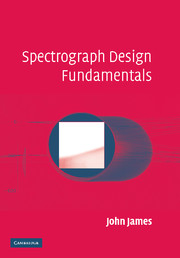Book contents
- Frontmatter
- Contents
- Preface
- Acknowledgements
- 1 A brief history of spectroscopy
- 2 The relevant regions of the electromagnetic spectrum
- 3 Geometrical optics
- 4 Optical aberrations
- 5 Fourier transforms: a brief revision
- 6 Physical optics and diffraction
- 7 The prism spectrograph
- 8 The plane grating spectrograph
- 9 The concave grating spectrograph
- 10 The interference spectrograph
- 11 The multiplex spectrometer
- 12 Detectors
- 13 Auxiliary optics
- 14 Optical design
- 15 Mechanical design and construction
- 16 Calibration
- 17 The alignment of a spectrograph
- Appendix 1 Optical aberrations
- Appendix 2 Wavelengths of spectral lines for calibration
- Appendix 3 The evolution of a Fabry–Perot interference spectrograph
- Appendix 4 The common calibration curve in silver halide spectrophotometry
- Bibliography
- Index
16 - Calibration
Published online by Cambridge University Press: 02 September 2009
- Frontmatter
- Contents
- Preface
- Acknowledgements
- 1 A brief history of spectroscopy
- 2 The relevant regions of the electromagnetic spectrum
- 3 Geometrical optics
- 4 Optical aberrations
- 5 Fourier transforms: a brief revision
- 6 Physical optics and diffraction
- 7 The prism spectrograph
- 8 The plane grating spectrograph
- 9 The concave grating spectrograph
- 10 The interference spectrograph
- 11 The multiplex spectrometer
- 12 Detectors
- 13 Auxiliary optics
- 14 Optical design
- 15 Mechanical design and construction
- 16 Calibration
- 17 The alignment of a spectrograph
- Appendix 1 Optical aberrations
- Appendix 2 Wavelengths of spectral lines for calibration
- Appendix 3 The evolution of a Fabry–Perot interference spectrograph
- Appendix 4 The common calibration curve in silver halide spectrophotometry
- Bibliography
- Index
Summary
Sensitivity calibration
There are so many variables in the optical path of a spectrograph that sensitivity calibration is necessarily totally empirical. A black body at a known temperature is the only feasible method of absolute calibration, and even then one must be sure that there has been a total suppression in the spectrograph of other orders and of scattered light. Reliable absolute calibration is such an onerous task that one must question the need for it in most circumstances. For almost all practical purposes a comparison with a standard source is sufficient. In the visible, a reasonable approximation – no more – can be obtained by making a spectrogram of a surface coated with freshly deposited magnesium oxide from burning magnesium ribbon which will scatter the light of the midday sun on a clear day. In the tropics and at moderate temperate latitudes, the midday sun is an approximation to a black body at 6000 K. Ordinary white card will not do as a scatterer, neither will a painted white matt surface because both are likely to be fluorescent under the UV solar radiation.
The resulting spectrum, after correction for the CCD pixel-to-pixel variations of sensitivity, may not look much like a textbook black body spectrum and for good reason. Firstly there are the basic variations with wavelength of the CCD overall sensitivity.
- Type
- Chapter
- Information
- Spectrograph Design Fundamentals , pp. 168 - 171Publisher: Cambridge University PressPrint publication year: 2007



